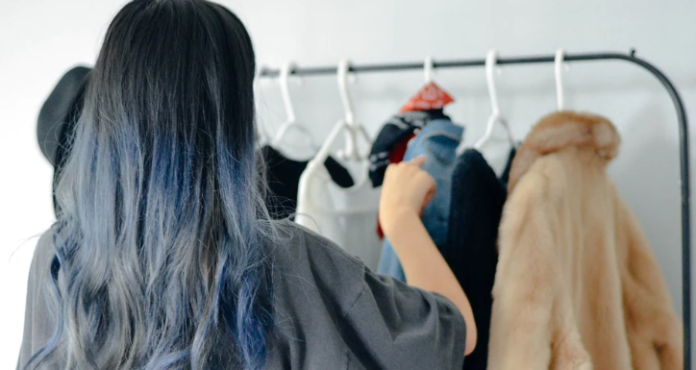A virtual fitting room is sheer convenience enjoyed by online shoppers while trying on items without touching them. These items could be anything – make-up, clothing, accessories. About 15 years ago, this technology made its debut, but it was the COVID-19 pandemic that made it popular. When retail sales witnessed a dramatic decline of 43.5% during the global lockdowns, shoppers were unable to visit and purchase products in-store. Even when they reopened, people were hesitant to stop by on their way to work for fear of the risk of exposure.
Fast forward to the present day, the technology powered by a robust combination of augmented reality (AR), virtual reality (VR) and artificial intelligence (AI) is offering an engaging shopping experience. It has alleviated the sizing concerns and taken brands forward by fulfilling their sustainability and inclusivity goals.
It works by scanning a person’s body, creating a 3D model and overlaying the scanned products on it. As soon as shoppers grant access to the camera, things start rolling. If you have played at a live casino before, you would know how the power of VR and 360-degree cameras allow players to participate in real-life casino games without having to leave their homely comforts behind.
Coming back to whether virtual fitting rooms would change the way people shop, let’s find out in the upcoming sections.
How Has Virtual Fitting Rooms Improved Customer Shopping Experience?
Let’s look at some advantages of implementing AR technologies in fashion retail.
- Lowered return rates
As per the reports published by Shopify, 30% of the orders are returned to eCommerce retailers for the product being too small in size. Similarly, 22% of the returns occurred because items were oversized. Ever since virtual fitting rooms came into existence, the problem of poor fit got eliminated. Zeekit, a retail technology company, has noticed a 36% fall in return rates ever since it started using virtual fitting rooms.
- Made the shopping experience faster and more convenient
Nowadays, people are always on the run. They rarely get the time to halt at a fashion retail outlet, try on multiple outfits and stand in the queue for a fitting room. Online shopping clubbed with virtual fitting rooms has saved their time to fulfil other priorities.
- Made shopping a fun activity
Tech-savvy customers always appreciate new and exciting inclusions. Virtual fitting rooms are fun to have and make shopping quite interesting. Customers are more drawn to them not just for convenience but for introducing a fun element.
- More tailored experience
A virtual shopping assistant not only helps in decision-making while shopping but offers a more tailored experience. It recommends complementary products you can get at a cheaper price and enjoy more value from a single purchase.
- Lowered abandonment rate
According to a report published in 2020, 97% of the consumers have revealed abandoning shopping purchases, citing inconvenience as the primary reason. Choosing the right fit from the hanger, swapping garments and walking over to a physical changing room were all major causes of disruption. Virtual fitting rooms resolved all.
Real-Life Examples of How Virtual Fitting Rooms Have Altered Shopper Experience for Better
The technology may have plenty of boons but a few limitations too. For instance, shoppers still do not get the feel of the fabric. Concerns like articles appear different in real life and technology implementation might be complicated and often hit one’s mind. However, top brands have overcome these challenges. Let’s look at how from this section.
Virtual try-on has already changed the way we shop, and here are some examples to back up the claim:
Amazon
Amazon, the eCommerce giant and the best apparel seller in the US, already has plans for virtual try-on up its sleeves. Some of its achievements in the tech field have been the introduction of AR-powered sneakers – a try-on feature that allowed shoppers to virtually put on shoes from Adidas, New Balance and Reebok before buying them.
Amazon has also applied for a patent on a blended reality system, which allow creation of AR mirrors. The great news is that the patent got granted in 2018. Wait till it’s commercialised. You can then try on clothes virtually and check how you would look when you wear them to the occasion. For instance, you can slip into swimwear virtually and examine how you would appear on a beach.
Nesting Olive
This brand, renowned for women’s maternity wear, presents shoppers with a virtual fitting room experience through Style.me. Women just need to create their avatar by entering height, weight and body type to check out themselves in the store’s featured dresses. You will not believe how it has boosted user engagement by 228% for the company.
Charlotte Tilbury
This luxury make-up brand was one of those that rendered an in-person digital experience by introducing the technology into its London-based flagship store. Shoppers call it the ‘magic mirror’ as it helps them browse different make-up looks. After its grand success, the brand found more motivation in implementing the virtual experience online and is doing great now.
Gucci
This luxury retailer is not far behind. When the malls closed down during the spread of the Coronavirus, it partnered with the AR pioneer of Snapchat to create its first line of AR shoes. The lens allowed customers to slip into them and shop their favourites directly through the Shop Now button.
Virtual fitting rooms have already made their mark on shoppers by changing their shopping behaviour. They have influenced primarily those from the younger generation and already created memorable experiences for them. After all these, we are sure nobody would like to go back to the conventional habit of visiting a store, queuing for a fitting room and trying on clothes. People are learning to value convenience more than anything else. Virtual fitting rooms deliver the right dose by lowering return rates and saving time and money.
































